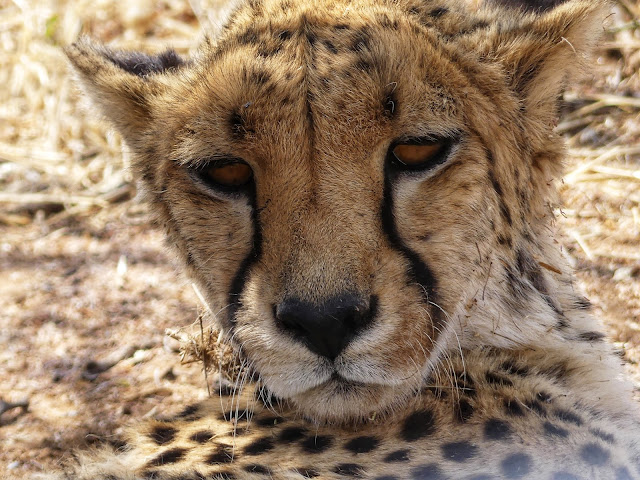It’s Sunday today, and we have been at our hunting lodge now since yesterday.
Events up until now included a stay near Waterberg National Park, a huge plateau rising up out of the plains. We took the time there to 1. Climb little Waterberg (the adjacent plateau, behind our guest house. Only Jim and I. The guest house dogs accompanied us to the top, which the owner says they sometimes to twice in a day. A heroic feat for the elderly Jack Russell terrier, who was panting to hard Jim shared his water. It felt like you could see all the way across Namibia from up there. Looking at the pic where Jim is on the rock, you can see the road across the owner’s land which we took that afternoon to the CCF: the Cheetah Conservation Fund.
This is a huge conservation area (one of several) founded to aid in conservation of cheetahs. Namibia has a larger population of them compared to South Africa, Botswana and other southern African countries, but all are going to be in real trouble within 10 years, according to our guide. Why: As usual, it’s complicated. Cheetahs, as compared to lions and leopards tend to hunt during the day. Read: they are more visible. They thus get blamed for kills they are not responsible for. They are fussy eaters, and can often kill a lamb each day and not finish it, as the next day they are looking for fresh meat, not that day old stuff. Habitat: human encroachment to be sure, but also: They are plains hunters. They need a grassland. There are many areas where there is a serious overgrowth of acacia bushes/trees which are evidently now invasive. And thorny. And obscure the view. In the wild they eventually die due to damage to their teeth and they starve to death. Like the elephants. So go see your dentist.
So CCF rescues cheetahs that are in conflict with humans, and where possible tries to rewild them. They keep the ones that cannot. Examples include the ones that were kept as pets until the owners could not do it any longer. Ones brought to the conservancy too early and they never had the chance to learn to hunt. They also work on a huge outreach to educate farmers to learn how to identify which cat is the predator (leopards bite from the top of the neck, cheetahs from underneath) and general public awareness. And they have a partnership with the Turkish government to raise Anatolian Shepards, a breed of dog that is highly effective as a guard dog to help with protecting sheep and goat herds. These are then given out to farmers who apply. And more. Like create habitats where cheetahs can hunt by clearing the Acacia. Which has a 40ft tap root. They take the larger pieces and process them to make biomass which can be used as firewood, and is what Karen works on in Alaska! World is small. The biomass is used in South Africa and also shipped to Germany. Which surprises me not at all. That’s an eland in the pic, which gives a moose a run for it’s money, sizewise...the upended branches in the front are the Acacias. And learned a ton about termite mounds.
Oh and we saw the largest meteor on earth. It’s really big. And heavy. Hoda farm has ceded land to the government as this is a national monument. And Bryce witnessed the mortal combat of 2 insects...








Great photos, great post. Now the crowd is asking for a geocaching-specific post!
ReplyDelete